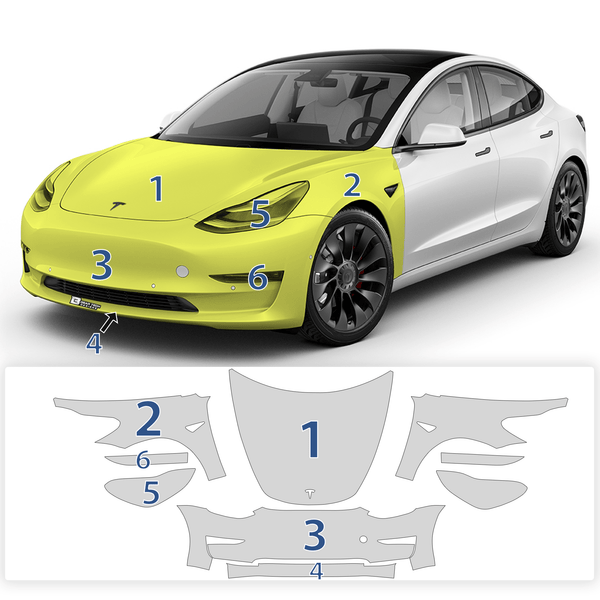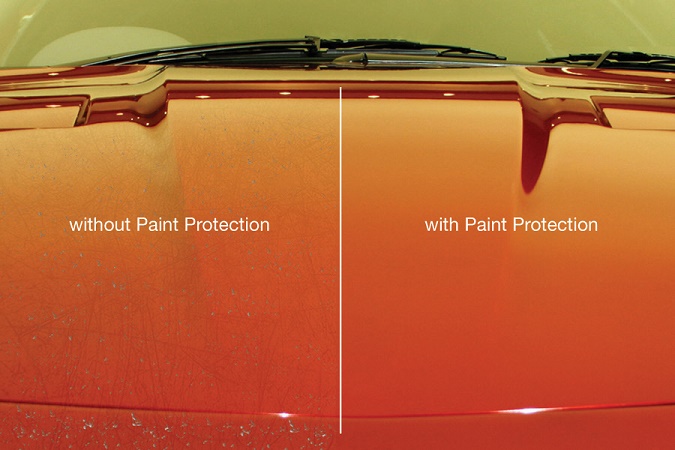All Concerning Paint Protection Film: Understanding Its Essential Role in Vehicle Treatment
Paint Protection Film (PPF) has actually become a crucial aspect of automobile care in the last few years. This transparent guard serves to protect a vehicle's outside from common hazards such as scrapes and environmental damage. Comprehending the mechanics behind PPF and its numerous advantages is important for lorry owners. However, several remain uninformed of the different types readily available and the setup procedure involved. What variables should one think about before applying PPF to their vehicle?

What Is Paint Protection Film?
Paint protection film (PPF) is a clear, long lasting layer developed to secure a vehicle's paint from damages. This sophisticated product, usually made from polyurethane, is engineered to withstand scratches, chips, and impurities, making certain the car keeps its visual charm with time. PPF can be put on numerous surface areas, consisting of the hood, fenders, and bumpers, providing targeted protection where it is most needed.The film is not only immune to use and tear yet likewise offers a self-healing residential property; minor scratches can vanish with direct exposure to warm. In addition, PPF works with different automobile finishes and can be tailored with regard to density and gloss levels. Its application has become progressively popular among vehicle enthusiasts and day-to-day chauffeurs alike, as it maintains the vehicle's worth and appearance. By investing in paint protection film, owners can appreciate a pristine outside while reducing upkeep initiatives.
Exactly How Does Paint Protection Film Job?
Paint protection film features by creating a resilient barrier that safeguards surfaces from square one and other physical damages. Additionally, it gives securing versus dangerous UV rays, which can discolor and weaken paint with time. Several modern films likewise include self-healing modern technology, allowing minor abrasions to vanish with warmth exposure.
Protection From Scratches
Securing a vehicle's exterior from scratches is a vital concern for many owners, and paint protection film (PPF) uses a dependable solution. This clear, polycarbonate urethane film is developed to abide by the lorry's surface, creating a barrier that soaks up impacts from roadway particles, branches, and various other prospective hazards. The film's flexibility enables it to extend and conform to various forms, making it ideal for various vehicle models. SpeedEFX Clear bra Centennial. Additionally, PPF is self-healing; small scrapes can vanish with warm direct exposure, keeping the automobile's look. By functioning as a durable shield, paint protection film properly reduces the threat of unattractive blemishes, preserving the aesthetic stability and resale worth of the automobile for many years to find
UV Ray Shielding
An automobile's outside faces multiple threats, including damaging UV rays that can discolor paint and weaken surfaces in time. Paint protection film (PPF) acts as an awesome obstacle versus these damaging ultraviolet rays. Made from advanced polymer products, PPF obstructs a considerable percentage of UV radiation, stopping it from penetrating the vehicle's clear coat and paint layers. This shielding impact not just maintains the lorry's color and coating but likewise prolongs the life-span of the paint. By successfully taking in and reflecting UV radiation, paint protection film minimizes the danger of oxidation and staining. Car proprietors that buy PPF can take pleasure in boosted looks and enhanced resale worth, understanding their vehicle is protected versus the damaging impacts of sun direct exposure.
Self-Healing Innovation

Benefits of Paint Protection Film
Paint Protection Film (PPF) offers many benefits for automobile owners looking for to preserve their car's appearance and value. Among the primary advantages is its capability to secure the lorry's paint from square one, chips, and environmental pollutants. This layer of protection aids preserve the manufacturing facility finish, avoiding pricey repainting or outlining. In addition, PPF is resistant to UV rays, which can trigger fading gradually, thus preserving the auto's aesthetic appeal.Another considerable advantage is the film's self-healing buildings; minor scratches can disappear with heat exposure, making certain the car continues to be aesthetically excellent. PPF is also simple to keep, calling for just regular washing to keep it looking fresh. Using paint protection film can boost resale value by showing that the lorry has actually been well cared for. Generally, PPF is a wise investment for those devoted to maintaining their vehicle's condition and prolonging its life expectancy.
Different Kinds of Paint Protection Film
Different sorts of Paint Protection Film (PPF) accommodate various needs and choices amongst vehicle owners. Clear bra films are among one of the most prominent alternatives, offering a clear layer that shields the vehicle's paint without modifying its look. These films are perfect for those that wish to maintain the original appearance of their car while guarding it from the ground up and road debris.Another type is self-healing film, which includes an one-of-a-kind polymer that can repair small scrapes and swirl marks when exposed to warm. This type offers enhanced longevity and aesthetic charm. In addition, tinted PPF is offered for those wanting to personalize the look of their lorry, permitting an one-of-a-kind surface while still giving protection.Lastly, distinctive films are made for certain surfaces, such as matte finishes, making certain that the safety high qualities do not jeopardize the car's style. Each kind of PPF offers unique objectives, improving both protection check here and customization.
Setup Refine for Paint Protection Film
The installation process for paint protection film begins with thorough surface prep work to ensure suitable attachment. This includes cleaning, brightening, and possibly correcting the automobile's paint to eliminate any flaws. Adhering to prep work, different application strategies are employed to efficiently use the film without bubbles or creases.
Surface Area Prep Work Steps
Before using paint protection film, precise surface prep work is important to ensure excellent adhesion and durability of the film. This process begins with a complete cleaning of the car's surface area to eliminate dust, grime, and contaminants. A top quality automobile soap must be used, adhered to by rinsing and drying with a microfiber towel to stop scratches. Next off, any existing wax or sealants need to be removed away, often using an isopropyl alcohol remedy to ensure a totally bare surface. Checking for flaws such as scrapes or swirl marks is crucial, as these can affect the film's look and efficiency. Cautious masking of nearby areas helps shield them throughout the installment process, assuring a clean and exact application.
Application Strategies Clarified
Mastering the application methods for paint protection film is essential for accomplishing a perfect coating. The installation procedure begins with careful placement of the film on the automobile's surface area, guaranteeing accurate placement over the desired location. When positioned, a solution of water and soap is often utilized to facilitate repositioning and bubble elimination. Smooth, regulated pressure is used using a squeegee, beginning with the facility and working external to eliminate air pockets. Heat may be used with a warm weapon to boost adhesion and help in contouring around curves and edges. After cutting excess film, the sides are sealed to prevent lifting. Appropriate method and attention to detail during setup ultimately boost the film's resilience and visual charm.
Upkeep and Look After Paint Protection Film
Correct upkeep and treatment are important for making sure the longevity and effectiveness of paint protection film. Regular cleansing is crucial; it is advised to clean the lorry with a pH-balanced, non-abrasive soap to stop any kind of damage to the film. Using soft microfiber towels for drying will assist stay clear of scratches.Avoiding automatic automobile cleans with brushes is advisable, as these can lift the sides of the film. Additionally, it is very important to quickly get rid of impurities such as bird droppings, tree sap, and road tar, as they can break down the film over time.For ideal protection, waxing the film every few months can enhance its luster and durability, however treatment should be required to make use of waxes that are secure for clear films. Normal examinations for any signs of training or bubbling need to additionally be conducted, permitting prompt repairs to preserve the honesty of the protection.
Regularly Asked Questions
How Much Time Does Paint Protection Film Normally Last?
The long life of paint protection film normally ranges between 5 to 10 years. Elements affecting its life-span consist of environmental problems, upkeep techniques, and the high quality of the film used, affecting total efficiency in shielding the vehicle's surface area.
Can Paint Protection Film Be Gotten Rid Of Without Damaging the Paint?
Getting rid of paint protection film can be done safely, typically without harming the underlying paint. Nonetheless, successful removal depends on the film's age, application technique, and the surface area condition, calling for cautious method to ensure paint integrity.
Is Paint Protection Film Visible As Soon As Set Up?
When mounted properly, paint protection film is created to be virtually unseen. SpeedEFX Clear bra Centennial. Some individuals may discover a mild sheen or appearance difference, depending on the car's paint and the film's high quality.
Does Paint Protection Film Protect Against UV Rays?
The concern of whether paint protection film secures against UV rays arises frequently. This film is made to shield the automobile's paint from dangerous ultraviolet radiation, assisting maintain the automobile's appearance over time.
Will Paint Protection Film Influence My Automobile's Resale Value?
The effect of paint protection film on a car's resale value can be positive, as it maintains the paint's problem. Possible purchasers may have varying point of views concerning its presence, affecting total marketability and perceived value.